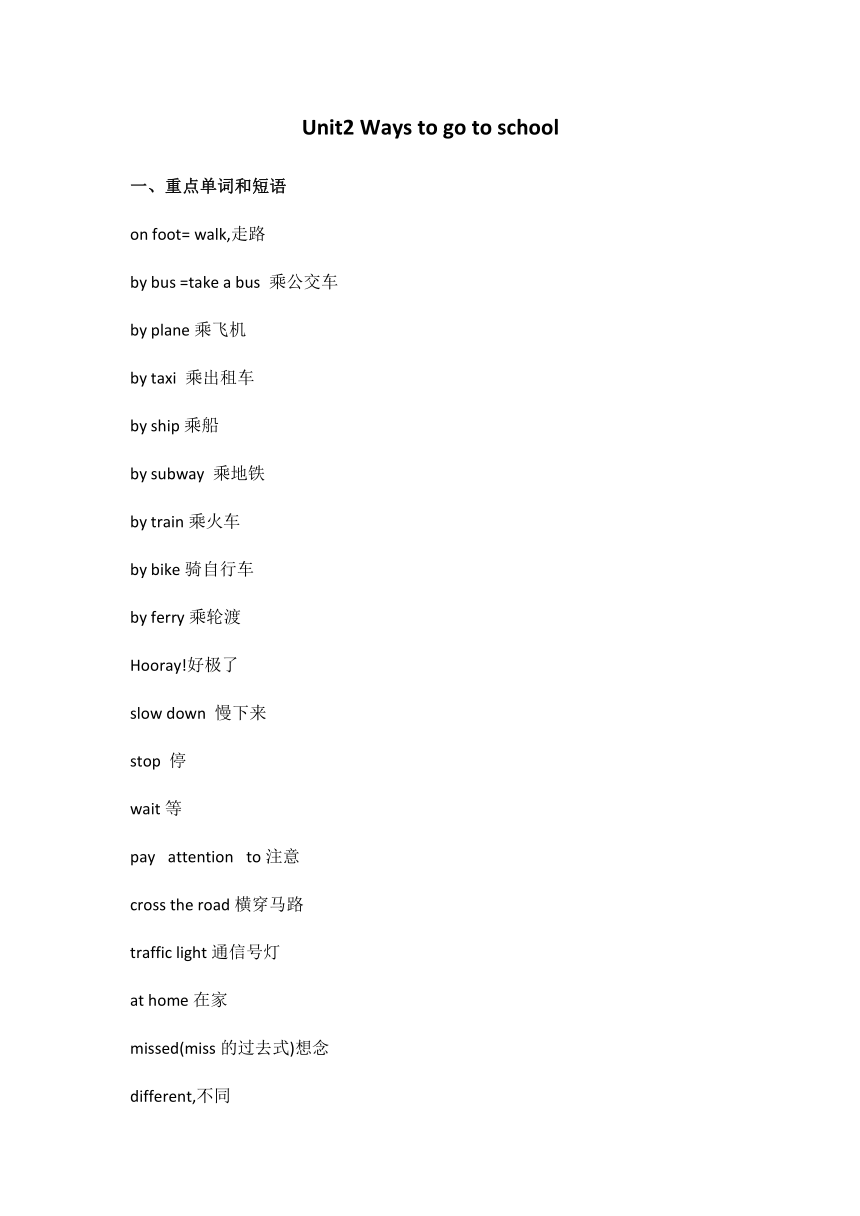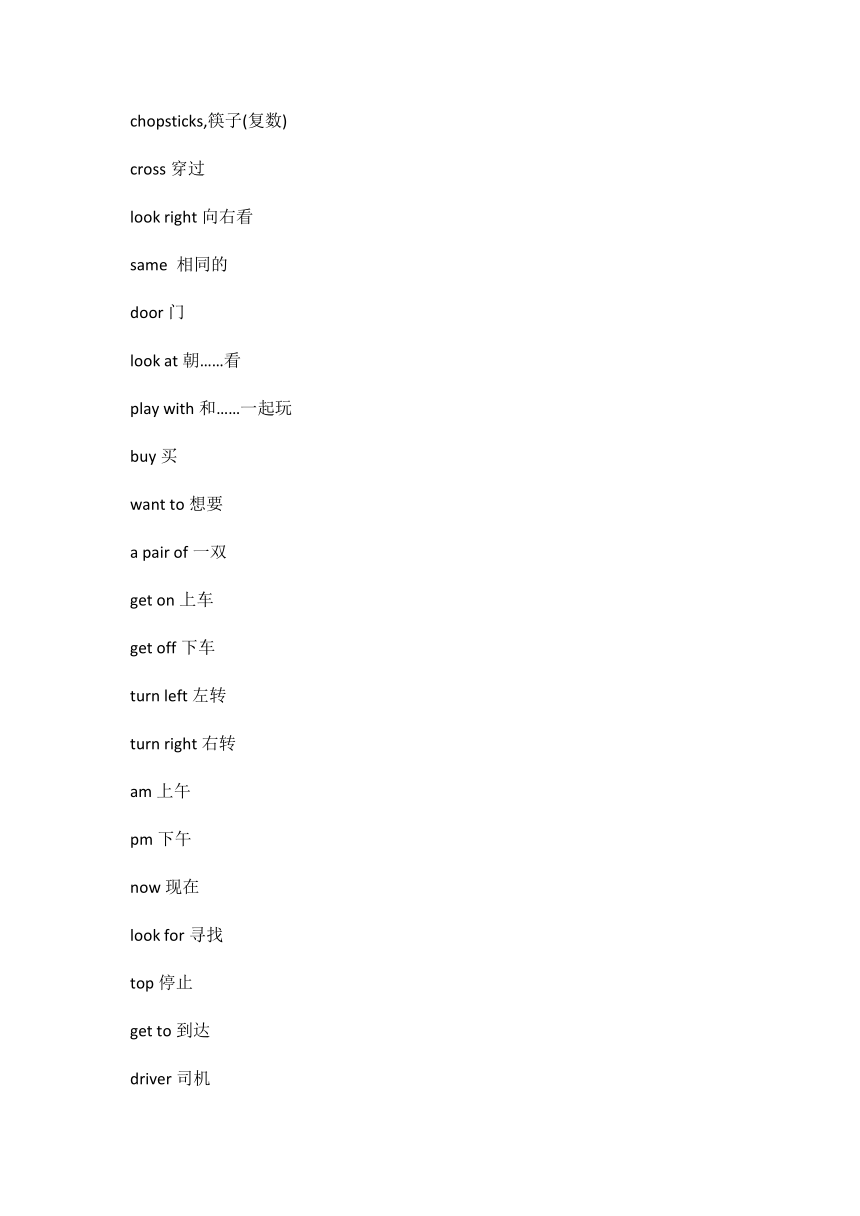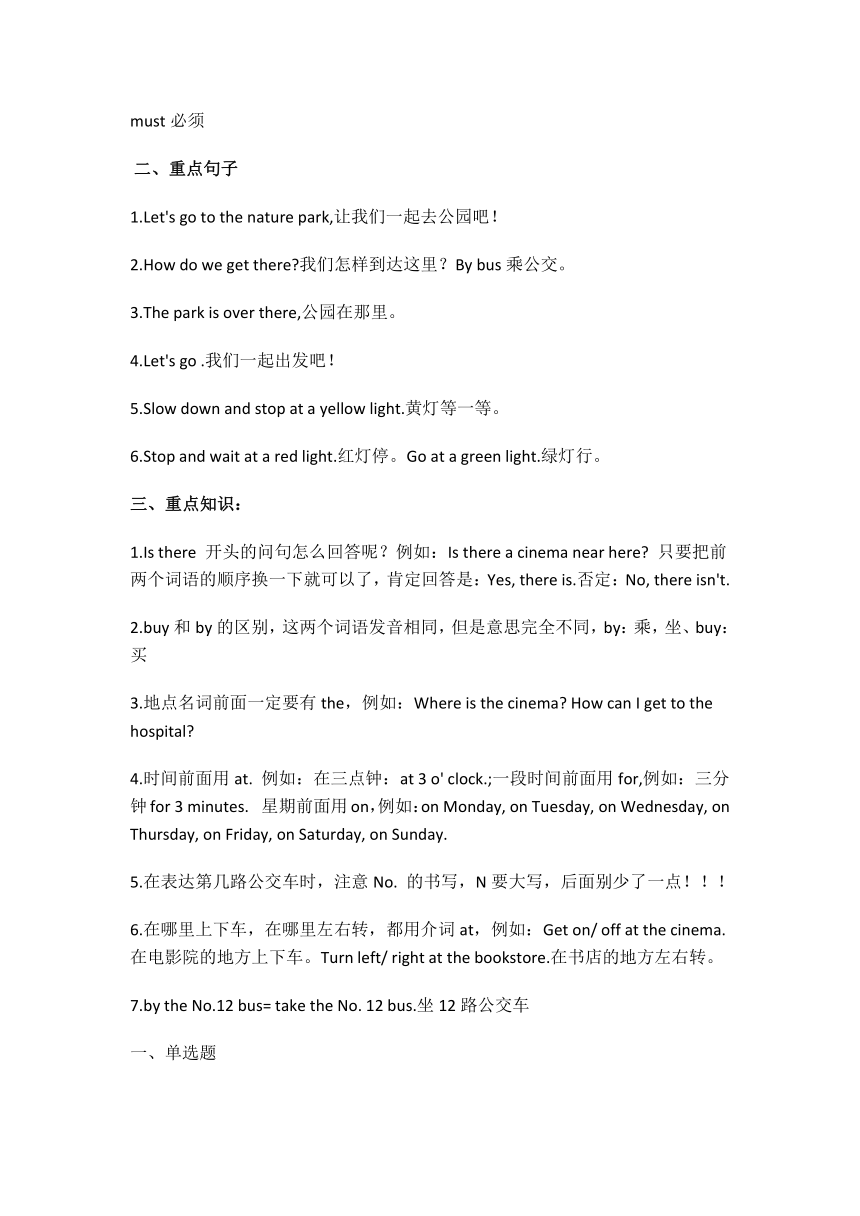 资源简介
资源简介
Unit2 Ways to go to school
一、重点单词和短语
on foot= walk,走路
by bus =take a bus 乘公交车
by plane乘飞机
by taxi 乘出租车
by ship乘船
by subway 乘地铁
by train乘火车
by bike骑自行车
by ferry乘轮渡
Hooray!好极了
slow down 慢下来
stop 停
wait等
pay attention to注意
cross the road横穿马路
traffic light通信号灯
at home在家
missed(miss的过去式)想念
different,不同
chopsticks,筷子(复数)
cross穿过
look right向右看
same 相同的
door门
look at朝……看
play with和……一起玩
buy买
want to想要
a pair of一双
get on上车
get off下车
turn left左转
turn right右转
am上午
pm下午
now现在
look for寻找
top停止
get to到达
driver司机
must必须
二、重点句子
1.Let's go to the nature park,让我们一起去公园吧!
2.How do we get there 我们怎样到达这里?By bus乘公交。
3.The park is over there,公园在那里。
4.Let's go .我们一起出发吧!
5.Slow down and stop at a yellow light.黄灯等一等。
6.Stop and wait at a red light.红灯停。Go at a green light.绿灯行。
三、重点知识:
1.Is there 开头的问句怎么回答呢?例如:Is there a cinema near here 只要把前两个词语的顺序换一下就可以了,肯定回答是:Yes, there is.否定:No, there isn't.
2.buy和by的区别,这两个词语发音相同,但是意思完全不同,by:乘,坐、buy:买
3.地点名词前面一定要有the,例如:Where is the cinema How can I get to the hospital
4.时间前面用at. 例如:在三点钟:at 3 o' clock.;一段时间前面用for,例如:三分钟for 3 minutes. 星期前面用on,例如:on Monday, on Tuesday, on Wednesday, on Thursday, on Friday, on Saturday, on Sunday.
5.在表达第几路公交车时,注意No. 的书写,N要大写,后面别少了一点!!!
6.在哪里上下车,在哪里左右转,都用介词at,例如:Get on/ off at the cinema.在电影院的地方上下车。Turn left/ right at the bookstore.在书店的地方左右转。
7.by the No.12 bus= take the No. 12 bus.坐12路公交车
一、单选题
1. How do you usually go to school
A. On foot
B. By bus
C. Both A and B
D. None of the above
2. If you want to cross the road safely, you should _______.
A. run quickly
B. look right and left
C. stop and wait
D. turn left
3. — How do we get to the zoo
— _______.
A. By plane
B. By taxi
C. By subway
D. All of the above
4. There _______ a bookstore near here.
A. is
B. are
C. have
D. has
5. The traffic lights are red. What should you do
A. Slow down
B. Stop and wait
C. Go
D. Turn left
6. I want to buy a pair of chopsticks. Where can I go
A. At home
B. At the supermarket
C. At the cinema
D. At the park
7. — Which bus can I take to get to the museum
— You can take the No. 10 bus.
— How do you spell No. 10
— _______.
A. N - o - ten
B. No. ten
C. N - ten
D. No, ten
8. When do you usually get up
A. At 7:00 am
B. For 7:00 am
C. On 7:00 am
D. In 7:00 am
9. Let's go to the park, _______
A. Will you
B. Shall we
C. Do you
D. Are you
10. You must _______ attention to the traffic rules.
A. pay
B. play
C. say
D. look
11. He _______ his homework at home yesterday.
A. do
B. does
C. did
D. is doing
12. — Where is the hospital
— It's _______ the post office.
A. near
B. in
C. on
D. behind
13. Turn left _______ the second crossing.
A. on
B. in
C. at
D. by
14. I'm looking for my pencil case. It's _______ the desk.
A. on
B. in
C. under
D. behind
15. The park is not far from here. We can get there _______.
A. by bike
B. by ship
C. by plane
D. by taxi
二、答案解析
1. 【答案】C
【解析】题目问通常如何去上学,on foot(步行)和by bus(乘公交车)都是常见的上学方式,both A and B表示两者皆可,所以选C。
2. 【答案】B
【解析】要安全过马路,应该左右看,look right and left符合要求,run quickly(快速跑)很危险,stop and wait(停下来等待)没有说明原因,turn left(左转)不符合过马路的常规操作,所以选B。
3. 【答案】D
【解析】去动物园的方式有多种,by plane(乘飞机)、by taxi(乘出租车)、by subway(乘地铁)都有可能,all of the above表示以上所有方式,所以选D。
4. 【答案】A
【解析】Is there开头的问句,回答遵循“Yes, there is.”或“No, there isn't.”的结构,这里书店是单数名词,所以选A。
5. 【答案】B
【解析】交通灯是红色的时候应该停下来等待,slow down(慢下来)不符合红灯的要求,go(走)和turn left(左转)都是错误的做法,所以选B。
6. 【答案】B
【解析】买筷子要去超市(supermarket),at home(在家)无法买到,at the cinema(在电影院)和at the park(在公园)也不是买筷子的地方,所以选B。
7. 【答案】A
【解析】No. 10的书写是N - o - ten,N要大写且后面不能少点,所以选A。
8. 【答案】A
【解析】at用于具体的时间点前,7:00 am是具体的上午时间点,for用于一段时间前,on用于星期前,in用于月份、年份等较大时间范围前,所以选A。
9. 【答案】B
【解析】Let's...表示建议,包括说话者在内,反问句用Shall we,Will you用于第二人称的建议或请求,Do you和Are you不符合此处语境,所以选B。
10. 【答案】A
【解析】pay attention to是固定短语,表示注意,play with是和……一起玩,say说,look看,都不符合此处语境,所以选A。
11. 【答案】C
【解析】yesterday是一般过去时的标志词,do homework是动词短语,其过去式是did homework,所以选C。
12. 【答案】A
【解析】描述医院和邮局的位置关系,near表示在……附近,in表示在……里面,on表示在……上面,behind表示在……后面,这里说医院在邮局附近,所以选A。
13. 【答案】C
【解析】at用于具体的地点前,表示在某个特定的点,这里指在第二个十字路口这个地点,on用于在物体的表面,in用于在物体的内部空间,by不用于这种表示地点方位的情况,所以选C。
14. 【答案】A
【解析】pencil case(铅笔盒)在桌子上,用on the desk表示,in表示在内部空间,under表示在下面,behind表示在后面,所以选A。
15. 【答案】A
【解析】公园不远,by bike(骑自行车)是比较合适的出行方式,by ship(乘轮渡)、by plane(乘飞机)、by taxi(乘出租车)对于不远的地方不太合适,所以选A。
展开更多......
收起↑
 资源预览
资源预览




 资源预览
资源预览



